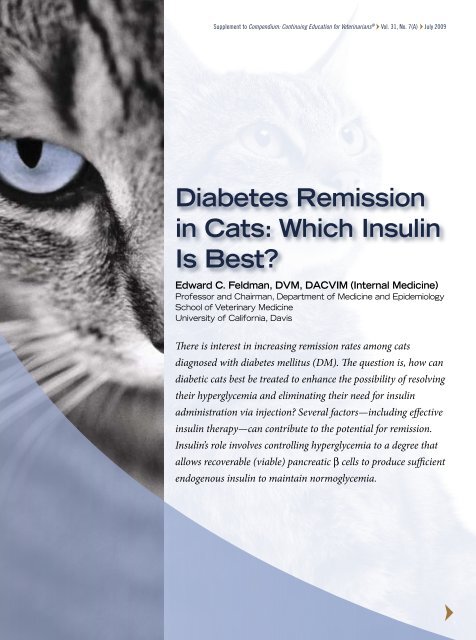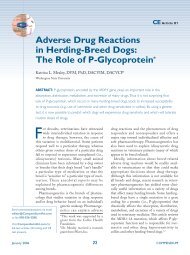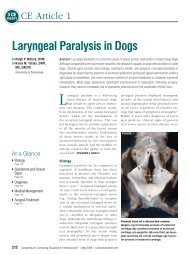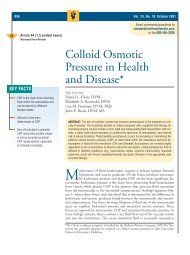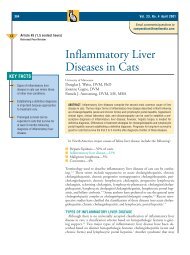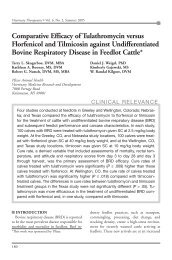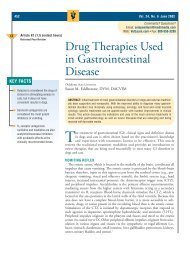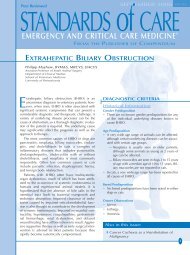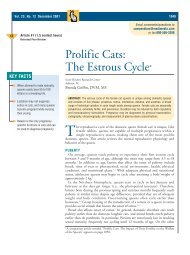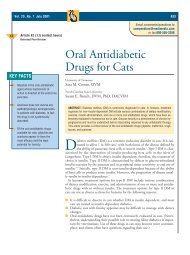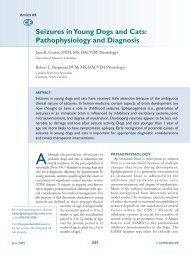Diabetes Remission in Cats: Which Insulin Is Best? - VetLearn.com
Diabetes Remission in Cats: Which Insulin Is Best? - VetLearn.com
Diabetes Remission in Cats: Which Insulin Is Best? - VetLearn.com
Create successful ePaper yourself
Turn your PDF publications into a flip-book with our unique Google optimized e-Paper software.
Supplement to Compendium: Cont<strong>in</strong>u<strong>in</strong>g Education for Veter<strong>in</strong>arians ® ➤ Vol. 31, No. 7(A) ➤ July 2009<br />
<strong>Diabetes</strong> <strong>Remission</strong><br />
<strong>in</strong> <strong>Cats</strong>: <strong>Which</strong> Insul<strong>in</strong><br />
<strong>Is</strong> <strong>Best</strong>?<br />
Edward C. Feldman, DVM, DACVIM (Internal Medic<strong>in</strong>e)<br />
Professor and Chairman, Department of Medic<strong>in</strong>e and Epidemiology<br />
School of Veter<strong>in</strong>ary Medic<strong>in</strong>e<br />
University of California, Davis<br />
There is <strong>in</strong>terest <strong>in</strong> <strong>in</strong>creas<strong>in</strong>g remission rates among cats<br />
diagnosed with diabetes mellitus (DM). The question is, how can<br />
diabetic cats best be treated to enhance the possibility of resolv<strong>in</strong>g<br />
their hyperglycemia and elim<strong>in</strong>at<strong>in</strong>g their need for <strong>in</strong>sul<strong>in</strong><br />
adm<strong>in</strong>istration via <strong>in</strong>jection? Several factors—<strong>in</strong>clud<strong>in</strong>g effective<br />
<strong>in</strong>sul<strong>in</strong> therapy—can contribute to the potential for remission.<br />
Insul<strong>in</strong>’s role <strong>in</strong>volves controll<strong>in</strong>g hyperglycemia to a degree that<br />
allows recoverable (viable) pancreatic b cells to produce sufficient<br />
endogenous <strong>in</strong>sul<strong>in</strong> to ma<strong>in</strong>ta<strong>in</strong> normoglycemia.<br />
➤
➤ ➤<br />
Important Considerations <strong>in</strong> Fel<strong>in</strong>e <strong>Diabetes</strong><br />
➤<br />
➤<br />
➤<br />
No s<strong>in</strong>gle <strong>in</strong>sul<strong>in</strong> type is more likely to <strong>in</strong>duce remission of DM; rather, control of<br />
hyperglycemia enhances the possibility of achiev<strong>in</strong>g remission. <strong>Remission</strong> of DM <strong>in</strong> cats is<br />
associated as much, or more, with the <strong>in</strong>troduction of a low-carbohydrate, high-prote<strong>in</strong> diet<br />
than with a particular type of <strong>in</strong>sul<strong>in</strong>.<br />
No test can differentiate between type 1 and type 2 DM <strong>in</strong> cats. “Type” of diabetes <strong>in</strong><br />
cats is derived from people and applied similarly to cats.<br />
TYPE 1 DM <strong>in</strong> people is def<strong>in</strong>ed as an absolute <strong>in</strong>sul<strong>in</strong> deficiency that is permanent<br />
(lifelong) and requires <strong>in</strong>sul<strong>in</strong> adm<strong>in</strong>istration for long-term survival. <strong>Remission</strong> is<br />
extremely rare.<br />
TYPE 2 DM <strong>in</strong> people is def<strong>in</strong>ed as a relative <strong>in</strong>sul<strong>in</strong> deficiency, typically associated with<br />
both <strong>in</strong>sul<strong>in</strong> resistance and an <strong>in</strong>ability to synthesize and secrete sufficient <strong>in</strong>sul<strong>in</strong> to<br />
ma<strong>in</strong>ta<strong>in</strong> glycemic control. Insul<strong>in</strong> resistance is most <strong>com</strong>monly associated with obesity,<br />
lack of exercise, and consumption of a diet too high <strong>in</strong> carbohydrates and too low <strong>in</strong> fiber.<br />
<strong>Remission</strong> of this type of DM is not only possible but is relatively <strong>com</strong>mon.<br />
TYPE 3 DM <strong>in</strong> people refers to an<br />
association with diseases or factors other<br />
than those <strong>in</strong>cluded <strong>in</strong> types 1 and<br />
2. These <strong>in</strong>clude diabetes occurr<strong>in</strong>g<br />
secondary to pancreatitis, pancreatic<br />
cancer, excess growth hormone, excess<br />
glucocorticoids, or adm<strong>in</strong>istration of<br />
<strong>in</strong>sul<strong>in</strong> antagonistic drugs.<br />
TYPE 4 DM <strong>in</strong> people refers to gestational<br />
diabetes.<br />
Among <strong>in</strong>sul<strong>in</strong>-treated diabetic cats, both underand<br />
overdosage of <strong>in</strong>sul<strong>in</strong> can contribute to<br />
poor glycemic control and hyperglycemia.<br />
Some of the most <strong>com</strong>mon causes of either<br />
under- or overdos<strong>in</strong>g are issues with how<br />
owners store, handle,<br />
or adm<strong>in</strong>ister<br />
<strong>in</strong>sul<strong>in</strong>.
OVERVIEW OF HUMAN AND<br />
FElINE DIABEtEs<br />
Background<br />
Based on histologic evidence of islet amyloidosis and<br />
b cell loss, as well as data from cl<strong>in</strong>ical trials, as<br />
many as 60% to 80% of cats with DM appear to have<br />
a condition similar to type 2 diabetes <strong>in</strong> humans. 1–4<br />
The cl<strong>in</strong>ical similarities between people and cats with<br />
DM <strong>in</strong>clude a higher <strong>in</strong>cidence of type 2 versus type<br />
1 diabetes <strong>in</strong> both species; onset <strong>in</strong> middle age; an<br />
association with obesity, <strong>in</strong>activity, and improper diet;<br />
related <strong>com</strong>plications such as neuropathy; and the<br />
potential for not need<strong>in</strong>g exogenous <strong>in</strong>sul<strong>in</strong> therapy<br />
through the use of proper treatment strategies. 3 As <strong>in</strong><br />
people, some diabetic cats have been shown to develop<br />
“<strong>in</strong>sul<strong>in</strong> resistance,” def<strong>in</strong>ed as a reduced capacity of<br />
tissues to respond to <strong>in</strong>sul<strong>in</strong>.<br />
<strong>Cats</strong> with <strong>in</strong>tr<strong>in</strong>sically low <strong>in</strong>sul<strong>in</strong> sensitivity are at<br />
<strong>in</strong>creased risk of develop<strong>in</strong>g glucose <strong>in</strong>tolerance with<br />
weight ga<strong>in</strong>. Male cats develop DM more <strong>com</strong>monly<br />
than female cats, perhaps partly because males have<br />
lower <strong>in</strong>sul<strong>in</strong> sensitivity. 5 This gender predisposition is<br />
one area <strong>in</strong> which there is an obvious difference between<br />
diabetic people and diabetic cats.<br />
Obesity is the most <strong>com</strong>mon cause of <strong>in</strong>sul<strong>in</strong><br />
resistance <strong>in</strong> people and is considered a likely cause<br />
for resistance with a similar physiologic background<br />
<strong>in</strong> cats. The <strong>in</strong>crease <strong>in</strong> obesity is paralleled with<br />
an <strong>in</strong>crease <strong>in</strong> the <strong>in</strong>cidence of type 2 diabetes.<br />
Adipose tissue (particularly central visceral stores)<br />
is an active endocr<strong>in</strong>e organ and part of the <strong>in</strong>nate<br />
immune system. Adipose tissue <strong>in</strong> lean people<br />
secretes relatively high levels of the adipocytok<strong>in</strong>e<br />
adiponect<strong>in</strong>, which has anti<strong>in</strong>flammatory action<br />
and is associated with <strong>in</strong>creased <strong>in</strong>sul<strong>in</strong> sensitivity<br />
and, therefore, a favorable metabolic status. With<br />
obesity, adiponect<strong>in</strong> secretion decreases and large<br />
amounts of nonesterified fatty acids, lept<strong>in</strong>, and<br />
pro<strong>in</strong>flammatory cytok<strong>in</strong>es are secreted by<br />
adipocytes and/or activated macrophages with<strong>in</strong><br />
the adipose tissue. These secretions impair<br />
<strong>in</strong>sul<strong>in</strong> signal<strong>in</strong>g and <strong>in</strong>duce or worsen <strong>in</strong>sul<strong>in</strong><br />
resistance. 6<br />
It is relevant to po<strong>in</strong>t out that not all<br />
obese cats be<strong>com</strong>e diabetic and that not<br />
all diabetic cats are obese. In one report,<br />
it was estimated that at the time of<br />
diagnosis, about 50% to 60% of diabetic<br />
cats are obese, 30% to 40% have a<br />
normal weight, and 5% to 10% are<br />
underweight. 7 Insul<strong>in</strong> resistance is<br />
also <strong>com</strong>monly associated with<br />
<strong>in</strong>fection or <strong>in</strong>flammatory<br />
Supplement to Compendium: Cont<strong>in</strong>u<strong>in</strong>g Education for Veter<strong>in</strong>arians ® ➤ Vol. 31, No. 7(A) ➤ July 2009<br />
conditions. Dysfunction of b cells is also crucial <strong>in</strong><br />
the development of type 2 DM because not all obese<br />
<strong>in</strong>dividuals (people or cats) develop diabetes.<br />
The exact nature of the underly<strong>in</strong>g mechanisms lead<strong>in</strong>g<br />
to b cell dysfunction is unclear. <strong>Is</strong>let cell mass <strong>in</strong><br />
<strong>in</strong>dividuals with type 2 DM is reduced by 40% to 60%<br />
as a result of apoptosis (a form of cell death). Apoptosis<br />
is likely triggered by a <strong>com</strong>b<strong>in</strong>ation of genetic and<br />
acquired factors. Acquired factors <strong>in</strong>clude glucose<br />
toxicity, lipotoxicity, and <strong>in</strong>creased deposition of amyloid<br />
<strong>in</strong> islets. 7<br />
In contrast to acute hyperglycemia, which stimulates<br />
<strong>in</strong>sul<strong>in</strong> secretion and glucose utilization, chronic<br />
hyperglycemia (glucose toxicity) impairs <strong>in</strong>sul<strong>in</strong><br />
secretion and contributes to <strong>in</strong>sul<strong>in</strong> resistance.<br />
Interest<strong>in</strong>gly, one of the first experiments on glucose<br />
toxicity was performed <strong>in</strong> cats: In 1948, researchers<br />
adm<strong>in</strong>istered large doses of glucose to normal cats<br />
and <strong>in</strong>duced permanent hyperglycemia, degeneration<br />
of islets, and ketonuria. 8 In more recent studies,<br />
chronic hyperglycemia <strong>in</strong> previously normal cats<br />
resulted <strong>in</strong> <strong>in</strong>sul<strong>in</strong> concentrations consistent with<br />
type 1 DM with<strong>in</strong> 5 days. 9<br />
Lipotoxicity refers to the deleterious effects fatty<br />
acids can have on b cells, a condition that likely<br />
requires hyperglycemia to be fully manifested. 10<br />
<strong>Is</strong>let amyloid is derived from amyl<strong>in</strong>, a prote<strong>in</strong><br />
co-secreted with <strong>in</strong>sul<strong>in</strong> from the pancreas. In a<br />
state of chronic <strong>in</strong>creases <strong>in</strong> <strong>in</strong>sul<strong>in</strong> secretion, as<br />
occurs with resistance, secretion of amyl<strong>in</strong> also<br />
<strong>in</strong>creases. This, <strong>in</strong> turn, can lead to <strong>in</strong>creased islet<br />
deposition of amyloid that contributes to b cell<br />
apoptosis. Amyloid deposition is found <strong>in</strong> 65%<br />
to 90% of cats with DM but is also <strong>com</strong>mon <strong>in</strong><br />
nondiabetic older cats. Therefore, amyloid is likely<br />
to be a contribut<strong>in</strong>g but not the primary cause of b<br />
cell failure. 11,12<br />
Thus, the pathogenesis of DM <strong>in</strong> <strong>in</strong>sul<strong>in</strong>-resistant<br />
cats is believed to <strong>in</strong>volve a cycle that <strong>in</strong>cludes <strong>in</strong>sul<strong>in</strong><br />
resistance <strong>in</strong> tissues (i.e., <strong>in</strong>sul<strong>in</strong> receptors that are less<br />
responsive than normal), <strong>in</strong>creased <strong>in</strong>sul<strong>in</strong> secretion,<br />
hyperglycemia, and, ultimately, b cell loss with reduced<br />
concentrations of <strong>in</strong>sul<strong>in</strong> secretion (Figure 1). <strong>Remission</strong><br />
is believed possible through reduction and stabilization<br />
of blood glucose concentrations <strong>in</strong> cats that have<br />
recoverable b cell function. 13,14 One must remember,<br />
however, that good diabetic control is often difficult<br />
to achieve. Treatment of diabetes always <strong>in</strong>volves an<br />
attempt to avoid significant under- or overdos<strong>in</strong>g of<br />
<strong>in</strong>sul<strong>in</strong>, as either can result <strong>in</strong> hyperglycemia, apparent<br />
resistance, and further b cell damage.<br />
➤ ➤ ➤
➤ ➤ ➤ ➤ <strong>Remission</strong> of the Diabetic state<br />
Factors that positively <strong>in</strong>fluence the likelihood of<br />
remission <strong>in</strong>clude the follow<strong>in</strong>g:<br />
➤ ➤<br />
➤<br />
Early diagnosis: <strong>Cats</strong> <strong>in</strong> the early stages of DM are more<br />
likely to have recoverable b cells <strong>com</strong>pared with cats that<br />
have more chronic disease; therefore, earlier diagnosis<br />
gives cats a better chance of achiev<strong>in</strong>g remission. 15<br />
Extent of b cell damage: Some cats are unable to<br />
achieve remission even with early treatment because<br />
either their b cells lack the capacity to recover and<br />
produce <strong>in</strong>sul<strong>in</strong> or they have persistent <strong>in</strong>sul<strong>in</strong><br />
resistance due to consumption of a less-than-ideal<br />
diet, obesity, <strong>in</strong>activity, chronic <strong>in</strong>flammation, chronic<br />
<strong>in</strong>fection, or any of a wide variety of other conditions.<br />
Inability to achieve diabetes remission could also be<br />
the result of irreversible b cell damage, whether simply<br />
from chronic type 2 diabetes or from destruction of<br />
cells by other causes, such as pancreatic cancer (type 3<br />
DM). Further, some cats appear to progress from type 2<br />
to type 1 DM regardless of the level of care provided, 14,16<br />
Figure 1. The vicious cycle of diabetes mellitus <strong>in</strong> cats.<br />
Low-Carbohydrate<br />
Diet<br />
Hepatic<br />
Gluconeogenesis<br />
–<br />
+<br />
High-Carbohydrate Diet<br />
+<br />
+<br />
= Decreases hyperglycemia<br />
= Increases hyperglycemia<br />
– –<br />
Hyperglycemia<br />
+<br />
Exogenous Insul<strong>in</strong><br />
The pathogenesis of DM <strong>in</strong> <strong>in</strong>sul<strong>in</strong>-resistant cats is believed to <strong>in</strong>volve a<br />
cycle that <strong>in</strong>cludes <strong>in</strong>sul<strong>in</strong> resistance <strong>in</strong> tissues (i.e., <strong>in</strong>sul<strong>in</strong> receptors that<br />
are less responsive than normal), <strong>in</strong>creased <strong>in</strong>sul<strong>in</strong> secretion, hyperglycemia,<br />
and, ultimately, b cell loss with reduced concentrations of <strong>in</strong>sul<strong>in</strong> secretion.<br />
+<br />
Glucose<br />
Toxicity<br />
b Cell<br />
Exhaustion<br />
Insul<strong>in</strong><br />
Resistance<br />
perhaps as a result of ongo<strong>in</strong>g immune-mediated<br />
destruction of pancreatic b cells.<br />
Effective <strong>in</strong>sul<strong>in</strong> treatment: The goal of <strong>in</strong>sul<strong>in</strong><br />
treatment is to ma<strong>in</strong>ta<strong>in</strong> blood glucose concentrations<br />
between 120 and 300 mg/dl (some researchers suggest<br />
attempt<strong>in</strong>g to ma<strong>in</strong>ta<strong>in</strong> blood glucose concentrations<br />
between 90 and 270 mg/dl). 5 Ma<strong>in</strong>ta<strong>in</strong><strong>in</strong>g blood glucose<br />
concentrations with<strong>in</strong> the standard laboratory reference<br />
range (~75 to 110 mg/dl) is not re<strong>com</strong>mended <strong>in</strong><br />
people or cats because attempts to ma<strong>in</strong>ta<strong>in</strong><br />
normoglycemia are often associated with overdosage,<br />
which can lead to severe life-threaten<strong>in</strong>g hypoglycemia<br />
and/or severe hyperglycemia. However, underdosage<br />
results <strong>in</strong> cont<strong>in</strong>u<strong>in</strong>g significant hyperglycemia and<br />
must also be avoided.<br />
Diet: Change of diet alone, particularly to one that is<br />
low <strong>in</strong> carbohydrates and high <strong>in</strong> prote<strong>in</strong>, may allow<br />
remission <strong>in</strong> about one-third of cats on <strong>in</strong>sul<strong>in</strong> therapy<br />
accord<strong>in</strong>g to some authors, 17–19 whereas others claim<br />
remission rates <strong>in</strong> excess of 50%. 5 A diet that is also<br />
high <strong>in</strong> fiber would likely be beneficial.<br />
Monitor<strong>in</strong>g: Low-stress or at-home blood glucose<br />
monitor<strong>in</strong>g is preferred as an aid <strong>in</strong> achiev<strong>in</strong>g glycemic<br />
control. 15,20 The answer to the question of how often<br />
diabetic cats should be monitored rema<strong>in</strong>s elusive, but<br />
an appropriate monitor<strong>in</strong>g schedule likely depends at<br />
least <strong>in</strong> part on <strong>in</strong>dividual cats and their owners.<br />
Duration of therapy: Although many cats that enter<br />
remission do so with<strong>in</strong> 16 weeks of <strong>in</strong>itiat<strong>in</strong>g <strong>in</strong>sul<strong>in</strong><br />
treatment, remission has been reported to occur as<br />
long as 30 months after diagnosis and <strong>in</strong>itiation of<br />
exogenous <strong>in</strong>sul<strong>in</strong> therapy. 17–19<br />
<strong>Remission</strong> may last for years, but diabetic cats that<br />
no longer require exogenous <strong>in</strong>sul<strong>in</strong> are not generally<br />
considered “cured.” Many cats that go <strong>in</strong>to remission are<br />
likely to have ongo<strong>in</strong>g subcl<strong>in</strong>ical pathology and the<br />
potential for recurrence. 14 The exception would be cats<br />
that are misdiagnosed with DM when they actually<br />
have temporary stress-<strong>in</strong>duced hyperglycemia.<br />
<strong>Remission</strong> <strong>in</strong> fel<strong>in</strong>e diabetes is <strong>com</strong>parable to the<br />
postpartum status of women with gestational<br />
diabetes (type 4 DM). Such women develop<br />
<strong>in</strong>sul<strong>in</strong> resistance because of <strong>in</strong>sul<strong>in</strong><br />
antagonism associated with the progesterone<br />
concentrations necessary to ma<strong>in</strong>ta<strong>in</strong><br />
pregnancy. Ultimately, progesterone<strong>in</strong>duced<br />
antagonism can lead to<br />
hyperglycemia dur<strong>in</strong>g pregnancy, but<br />
there is the potential for return to<br />
euglycemia once progesterone<br />
decreases after pregnancy.<br />
Studies have shown that
women with a history of gestational diabetes may be 70% more<br />
likely to develop cl<strong>in</strong>ical diabetes later <strong>in</strong> life than women with no<br />
such history. 21,22<br />
Fel<strong>in</strong>e DM is a disease that requires lifelong care and<br />
monitor<strong>in</strong>g, even dur<strong>in</strong>g phases of remission. The onset<br />
of cl<strong>in</strong>ical disease <strong>in</strong> cats can be associated with events<br />
that <strong>in</strong>crease <strong>in</strong>sul<strong>in</strong> resistance, most notably <strong>in</strong>door<br />
conf<strong>in</strong>ement and physical <strong>in</strong>activity; obesity; and feed<strong>in</strong>g<br />
a high-carbohydrate, low-prote<strong>in</strong> diet. The second tier of<br />
contributors to chronic <strong>in</strong>sul<strong>in</strong> resistance <strong>in</strong>cludes chronic<br />
<strong>in</strong>fection (especially periodontal disease, sk<strong>in</strong> disease, or<br />
ur<strong>in</strong>ary tract <strong>in</strong>fection) and chronic <strong>in</strong>flammatory conditions<br />
(especially periodontal disease and pancreatitis). Certa<strong>in</strong><br />
medications (e.g., glucocorticoids) are known to cause <strong>in</strong>sul<strong>in</strong><br />
resistance. Many other chronic illnesses (e.g., kidney disease,<br />
heart failure) can lead to <strong>in</strong>sul<strong>in</strong> resistance as well. Much<br />
less <strong>com</strong>mon but still important causes of <strong>in</strong>sul<strong>in</strong> resistance<br />
<strong>in</strong>clude diseases associated with excess production of <strong>in</strong>sul<strong>in</strong><br />
antagonistic hormones, such as acromegaly (growth hormone)<br />
and hyperadrenocorticism (glucocorticoids). 3,23–25<br />
Because DM <strong>in</strong> some cats is similar to type 2 diabetes <strong>in</strong><br />
humans, management of the disease should also be similar.<br />
The cornerstones of type 2 diabetes management <strong>in</strong> people<br />
<strong>in</strong>clude weight loss, switch<strong>in</strong>g to a diet lower <strong>in</strong> carbohydrates<br />
and higher <strong>in</strong> fiber, and exercise. Prevention and/or treatment<br />
of concurrent diseases (especially those associated with<br />
<strong>in</strong>fection and/or <strong>in</strong>flammation) can assist <strong>in</strong> stabiliz<strong>in</strong>g<br />
blood glucose concentrations and reduc<strong>in</strong>g the need for<br />
<strong>in</strong>sul<strong>in</strong>. 17–19,26,27<br />
Because cats are generally diagnosed after chronic<br />
hyperglycemia develops, stabilization of blood glucose with<br />
<strong>in</strong>sul<strong>in</strong> may be a core therapeutic strategy along with chang<strong>in</strong>g<br />
the diet. Veter<strong>in</strong>ary practitioners must decide which <strong>in</strong>sul<strong>in</strong> to<br />
use based on available published data.<br />
the Importance of Diet<br />
Diet is one of the understated factors <strong>in</strong> reported remission<br />
rates among cats with DM. This be<strong>com</strong>es obvious when<br />
review<strong>in</strong>g studies reported to date. Switch<strong>in</strong>g diabetic cats that<br />
are already be<strong>in</strong>g treated with <strong>in</strong>sul<strong>in</strong> to a low-carbohydrate,<br />
high-prote<strong>in</strong> diet can have a significant <strong>in</strong>fluence on the<br />
likelihood of remission. This is true <strong>in</strong> as many as 50% of<br />
afflicted cats. 5 The bottom l<strong>in</strong>e is that cats are metabolically<br />
adapted to consume primarily prote<strong>in</strong> and fat, and diets high<br />
<strong>in</strong> carbohydrates appear to be unfavorable. It has been shown<br />
that feed<strong>in</strong>g a low-carbohydrate, high-prote<strong>in</strong> diet results <strong>in</strong><br />
Supplement to Compendium: Cont<strong>in</strong>u<strong>in</strong>g Education for Veter<strong>in</strong>arians ® ➤ Vol. 31, No. 7(A) ➤ July 2009<br />
better cl<strong>in</strong>ical control and <strong>in</strong>creased rates of diabetic remission.<br />
Accord<strong>in</strong>g to data from the University of Zurich, Switzerland,<br />
remission rates are 15% to 25% when diets with variable<br />
<strong>com</strong>positions are fed and exceed 50% when high-prote<strong>in</strong>, lowcarbohydrate<br />
diets are fed. The positive effect of diet change is<br />
often evident before any apparent loss of body weight can be<br />
documented. 5<br />
tHE REsEARCH: INsUlIN tHERApy AND<br />
REM<strong>Is</strong>sION IN CAts<br />
There has been discussion regard<strong>in</strong>g the use of porc<strong>in</strong>e, bov<strong>in</strong>e,<br />
and human <strong>in</strong>sul<strong>in</strong>s and the importance of their differ<strong>in</strong>g am<strong>in</strong>o<br />
acid sequences as <strong>com</strong>pared with natural cat <strong>in</strong>sul<strong>in</strong>. Dog and<br />
porc<strong>in</strong>e <strong>in</strong>sul<strong>in</strong>s are similar, as are cat and bov<strong>in</strong>e <strong>in</strong>sul<strong>in</strong>s.<br />
Experience suggests that am<strong>in</strong>o acid differences are not critical<br />
<strong>in</strong> determ<strong>in</strong><strong>in</strong>g the <strong>in</strong>sul<strong>in</strong> type used <strong>in</strong> manag<strong>in</strong>g DM. Rather,<br />
When <strong>com</strong>b<strong>in</strong>ed with other key factors <strong>in</strong><br />
diabetes management, any <strong>in</strong>sul<strong>in</strong> that helps achieve proper<br />
glycemic control can enhance the chances for remission.<br />
it is the dose and frequency of <strong>in</strong>sul<strong>in</strong> adm<strong>in</strong>istration, diet, and<br />
many other factors that determ<strong>in</strong>e success or failure <strong>in</strong> therapy<br />
or the achievement of remission. Also, because any cat may<br />
respond better to one <strong>in</strong>sul<strong>in</strong> than to another, hav<strong>in</strong>g several<br />
choices is always an advantage.<br />
porc<strong>in</strong>e Insul<strong>in</strong> Z<strong>in</strong>c suspension without<br />
Dietary Restrictions<br />
Several studies have evaluated the use of porc<strong>in</strong>e <strong>in</strong>sul<strong>in</strong> z<strong>in</strong>c<br />
suspension (Vetsul<strong>in</strong>® [United States] and Can<strong>in</strong>sul<strong>in</strong>® [outside<br />
the US], Intervet/Scher<strong>in</strong>g-Plough Animal Health) <strong>in</strong> the<br />
management of diabetic cats. Porc<strong>in</strong>e <strong>in</strong>sul<strong>in</strong> z<strong>in</strong>c suspension is<br />
classified as an <strong>in</strong>termediate-act<strong>in</strong>g Lente <strong>in</strong>sul<strong>in</strong>. Most studies<br />
<strong>in</strong>clude both cats with newly diagnosed DM and those with<br />
previously diagnosed and treated DM. Further, cats were not<br />
required to be on a specific diet to be entered <strong>in</strong>to some studies.<br />
This <strong>in</strong>formation is useful, especially consider<strong>in</strong>g the potential<br />
variation among cats with diabetes and the variability of success<br />
<strong>in</strong> controll<strong>in</strong>g their diet.<br />
The largest studies of <strong>in</strong>sul<strong>in</strong> therapy without dietary<br />
modification carried out <strong>in</strong> the United States are the field<br />
trials whose data supported the addition of the fel<strong>in</strong>e claim<br />
to the Vetsul<strong>in</strong> label. Reported remission rates <strong>in</strong> two field<br />
trials were 33% (4 of 12) and 13% (8 of 61) of the cats studied,<br />
respectively. 28 The generally tighter serum glucose control,<br />
based on fructosam<strong>in</strong>e and mean glucose concentrations,<br />
achieved <strong>in</strong> the first trial may have been responsible for the<br />
higher percentage of remissions. These remission rates were<br />
achieved without changes <strong>in</strong> diet. <strong>Remission</strong> rates might<br />
➤ ➤ ➤ ➤ ➤
➤ ➤ ➤ ➤ ➤ ➤<br />
have been higher if low-carbohydrate diets (with or without<br />
<strong>in</strong>creased fiber) had been required <strong>in</strong> all cats.<br />
Other studies that grouped new and previously treated<br />
diabetic cats and that had no dietary requirements identified<br />
similar numbers of cats go<strong>in</strong>g <strong>in</strong>to remission with porc<strong>in</strong>e<br />
<strong>in</strong>sul<strong>in</strong> z<strong>in</strong>c suspension treatment. These prospective cl<strong>in</strong>ical<br />
studies reported 41% (13 of 32 cats) <strong>in</strong> remission with<strong>in</strong><br />
16 weeks of beg<strong>in</strong>n<strong>in</strong>g porc<strong>in</strong>e <strong>in</strong>sul<strong>in</strong> z<strong>in</strong>c suspension<br />
treatment, 28% (7 of 25 cats) <strong>in</strong> remission with<strong>in</strong> 12 months,<br />
and 17% (8 of 46 cats) reach<strong>in</strong>g remission with<strong>in</strong> about 16<br />
weeks. 29–31<br />
porc<strong>in</strong>e Insul<strong>in</strong> Z<strong>in</strong>c suspension <strong>in</strong> <strong>Cats</strong> with<br />
<strong>Diabetes</strong> Mellitus and severe Ketoacidosis<br />
Porc<strong>in</strong>e <strong>in</strong>sul<strong>in</strong> z<strong>in</strong>c suspension is the only available <strong>in</strong>sul<strong>in</strong><br />
for which diabetes remission was documented <strong>in</strong> cats that<br />
previously had severe diabetic ketoacidosis (DKA). Sieber-<br />
Ruckstuhl and associates conducted a retrospective study of cats<br />
presented to the veter<strong>in</strong>ary teach<strong>in</strong>g hospital at the University of<br />
Zurich, Switzerland, from 2003 to 2007. 32 <strong>Cats</strong> newly diagnosed<br />
with documented diabetes and ketoacidosis were studied.<br />
Once DKA resolved via treatment with a standardized protocol<br />
that <strong>in</strong>cluded the use of short-act<strong>in</strong>g <strong>in</strong>sul<strong>in</strong>, <strong>in</strong>sul<strong>in</strong> therapy<br />
was changed to porc<strong>in</strong>e <strong>in</strong>sul<strong>in</strong> z<strong>in</strong>c suspension (Vetsul<strong>in</strong>).<br />
This <strong>in</strong>sul<strong>in</strong> was given at a start<strong>in</strong>g dose of 0.25 to 0.5 U/kg<br />
q12h. The cats were also fed a <strong>com</strong>mercial low-carbohydrate,<br />
high-prote<strong>in</strong> diet. Seven of 12 (58%) cats that were <strong>in</strong>itially<br />
ketoacidotic achieved remissions last<strong>in</strong>g as long as 3 years.<br />
These cats had more pancreatic disease, bacterial ur<strong>in</strong>ary tract<br />
<strong>in</strong>fections, and cardiomyopathy than cats at the same hospital<br />
with newly diagnosed un<strong>com</strong>plicated DM achiev<strong>in</strong>g remission.<br />
Thus, DKA, once thought to occur only <strong>in</strong> cats with type 1 DM,<br />
has been documented <strong>in</strong> cats with type 2 disease as well. These<br />
data demonstrate that cats with DKA can eventually achieve<br />
remission from diabetes through appropriate <strong>in</strong>sul<strong>in</strong> and<br />
dietary therapy.<br />
lente Insul<strong>in</strong> versus Insul<strong>in</strong> Glarg<strong>in</strong>e <strong>in</strong> <strong>Cats</strong> Fed a<br />
low-Carbohydrate, High-prote<strong>in</strong> Diet<br />
A randomized, open study by Weaver and colleagues<br />
<strong>in</strong>vestigated human re<strong>com</strong>b<strong>in</strong>ant Lente <strong>in</strong>sul<strong>in</strong> (0.5 U/kg q12h;<br />
n = 7) versus <strong>in</strong>sul<strong>in</strong> glarg<strong>in</strong>e (0.5 U/kg q24h; n = 6). There were<br />
three newly diagnosed cats <strong>in</strong> the Lente-treated group and five<br />
<strong>in</strong> the <strong>in</strong>sul<strong>in</strong> glarg<strong>in</strong>e–treated group; the other five cats had<br />
been previously treated, but glycemic control was poor. All the<br />
cats were fed low-carbohydrate, high-prote<strong>in</strong> diets and were<br />
monitored for 12 weeks. Three of the Lente-treated cats (43%)<br />
and one of the <strong>in</strong>sul<strong>in</strong> glarg<strong>in</strong>e–treated cats (17%) went <strong>in</strong>to<br />
remission. 33<br />
Reports of diabetic cats fed a low-carbohydrate, high-prote<strong>in</strong><br />
diet <strong>in</strong>clude a study by Boari et al that <strong>in</strong>vestigated five newly<br />
diagnosed and previously treated diabetic cats adm<strong>in</strong>istered<br />
<strong>in</strong>sul<strong>in</strong> glarg<strong>in</strong>e at an <strong>in</strong>itial dose of 0.25 to 0.5 U/kg twice daily.<br />
They reported that two of five cats (40%) went <strong>in</strong>to remission<br />
with<strong>in</strong> 12 weeks. 34 Roomp and Rand looked primarily at<br />
previously treated cats (50 of 55 cats) and began treatment<br />
with <strong>in</strong>sul<strong>in</strong> glarg<strong>in</strong>e twice a day (dose not specified) with<br />
the addition of home monitor<strong>in</strong>g via glucose curves (another<br />
glycemic control factor); 64% (35 of 55) of the cats achieved<br />
remission. 15<br />
A study by Hall and colleagues suggested that diet did not<br />
have the <strong>in</strong>tended effect on fel<strong>in</strong>e metabolism. Their study was<br />
designed to differentiate between the effects of a ma<strong>in</strong>tenance<br />
Additional research will likely cont<strong>in</strong>ue to support the evidence that<br />
<strong>in</strong> newly diagnosed cats on a total diabetes management program,<br />
<strong>in</strong>clud<strong>in</strong>g dietary control, remission rates with Vetsul<strong>in</strong> treatment<br />
will be <strong>com</strong>parable to those achieved with other <strong>in</strong>sul<strong>in</strong> types.<br />
diet (six cats) and a low-carbohydrate, high-prote<strong>in</strong> diet (six<br />
cats) <strong>in</strong> diabetic cats. The authors noted that their ma<strong>in</strong>tenance<br />
diet may have been too low <strong>in</strong> carbohydrates to serve as a<br />
control. Also, obese cats did not lose weight and cats that were<br />
not overweight at the beg<strong>in</strong>n<strong>in</strong>g of the study became overweight<br />
dur<strong>in</strong>g the study. Half the cats were newly diagnosed with DM,<br />
and all received <strong>in</strong>sul<strong>in</strong> glarg<strong>in</strong>e at an <strong>in</strong>itial dose of 0.25 U/kg<br />
twice daily. Two cats (17%)—one from each diet group—went<br />
<strong>in</strong>to remission with<strong>in</strong> 10 weeks. 35<br />
lente Insul<strong>in</strong>, protam<strong>in</strong>e Z<strong>in</strong>c Insul<strong>in</strong>, or Insul<strong>in</strong><br />
Glarg<strong>in</strong>e <strong>in</strong> Newly Diagnosed <strong>Cats</strong> on a low-<br />
Carbohydrate, High-prote<strong>in</strong> Diet<br />
In 2005, Marshall and Rand reported a prospective cl<strong>in</strong>ical<br />
study limited to newly diagnosed diabetic cats fed a lowcarbohydrate,<br />
high-prote<strong>in</strong> diet. Although this study is<br />
<strong>com</strong>monly cited, only an abstract—not the <strong>com</strong>plete study—<br />
has been published. 36 Inclusion criteria and randomization<br />
techniques used were not reported, and this study should<br />
rema<strong>in</strong> outside of decision processes until it has been<br />
appropriately reviewed and published. <strong>Cats</strong> were treated with<br />
Lente <strong>in</strong>sul<strong>in</strong>, protam<strong>in</strong>e z<strong>in</strong>c <strong>in</strong>sul<strong>in</strong>, or <strong>in</strong>sul<strong>in</strong> glarg<strong>in</strong>e at<br />
an <strong>in</strong>itial dose of 0.25 to 0.5 U/kg twice daily. In this study,<br />
25% (two of eight) of Lente-treated cats, 38% (three of eight)<br />
of protam<strong>in</strong>e z<strong>in</strong>c <strong>in</strong>sul<strong>in</strong>–treated cats, and 100% (eight of<br />
eight) of <strong>in</strong>sul<strong>in</strong> glarg<strong>in</strong>e–treated cats went <strong>in</strong>to remission<br />
with<strong>in</strong> 16 weeks. The high level of remission observed <strong>in</strong> the
<strong>in</strong>sul<strong>in</strong> glarg<strong>in</strong>e–treated cats has not been replicated<br />
<strong>in</strong> other studies.<br />
porc<strong>in</strong>e Insul<strong>in</strong> Z<strong>in</strong>c suspension<br />
versus Insul<strong>in</strong> Glarg<strong>in</strong>e<br />
No statistical difference <strong>in</strong> remission rates can be shown<br />
between Lente <strong>in</strong>sul<strong>in</strong> (Vetsul<strong>in</strong>) and <strong>in</strong>sul<strong>in</strong> glarg<strong>in</strong>e<br />
when diet is controlled. 37 A meta-analysis of the available<br />
data regard<strong>in</strong>g cats fed a low-carbohydrate, high-prote<strong>in</strong><br />
diet demonstrates no statistically significant difference<br />
(P = .196) <strong>in</strong> remission rates among diabetic cats treated<br />
with Lente <strong>in</strong>sul<strong>in</strong> (44.4%) and those treated with <strong>in</strong>sul<strong>in</strong><br />
glarg<strong>in</strong>e (58.8 %) (Table 1). The achievement of good<br />
glycemic control <strong>in</strong> any diabetic cat, regardless of <strong>in</strong>sul<strong>in</strong><br />
type used, improves the chances for achiev<strong>in</strong>g remission<br />
when used <strong>in</strong> <strong>com</strong>b<strong>in</strong>ation with other factors known to<br />
contribute to DM remission <strong>in</strong> cats.<br />
Conclusion<br />
Based on data from available studies, porc<strong>in</strong>e <strong>in</strong>sul<strong>in</strong><br />
z<strong>in</strong>c suspension (Vetsul<strong>in</strong>) is effective <strong>in</strong> achiev<strong>in</strong>g<br />
remission <strong>in</strong> diabetic cats that are not on a controlled<br />
diet (13% to 41%). 28 These results are similar to those<br />
achieved with the use of other <strong>in</strong>sul<strong>in</strong> types under<br />
<strong>com</strong>parable conditions. 16,17,33 In addition, porc<strong>in</strong>e<br />
<strong>in</strong>sul<strong>in</strong> z<strong>in</strong>c suspension is effective <strong>in</strong> achiev<strong>in</strong>g<br />
remission <strong>in</strong> cats that have had severe DKA (58%). 32<br />
No statistical difference <strong>in</strong> remission rates can be shown<br />
between Lente <strong>in</strong>sul<strong>in</strong> (<strong>in</strong>clud<strong>in</strong>g Vetsul<strong>in</strong>) and <strong>in</strong>sul<strong>in</strong><br />
glarg<strong>in</strong>e when diet is controlled. 37<br />
Because nearly all of the studies report<strong>in</strong>g<br />
remissions with <strong>in</strong>sul<strong>in</strong> types other than porc<strong>in</strong>e<br />
<strong>in</strong>sul<strong>in</strong> z<strong>in</strong>c suspension (Vetsul<strong>in</strong>) also <strong>in</strong>cluded other<br />
diabetes management strategies (e.g., dietary control)<br />
<strong>in</strong> their design, simple <strong>com</strong>parison of remissions<br />
achieved without consider<strong>in</strong>g these factors can be<br />
mislead<strong>in</strong>g. For example, with the exception of<br />
one study, the data available for <strong>in</strong>sul<strong>in</strong> glarg<strong>in</strong>e–<br />
treated cats are from studies performed <strong>in</strong> cats fed<br />
a low-carbohydrate, high-prote<strong>in</strong> diet (Table 1).<br />
Switch<strong>in</strong>g to this type of diet led to remission<br />
<strong>in</strong> three of n<strong>in</strong>e cats that were already be<strong>in</strong>g<br />
treated and stabilized with <strong>in</strong>sul<strong>in</strong>. 18 Such<br />
a switch also <strong>in</strong>creased the number of<br />
remissions <strong>in</strong> a study by Bennett and<br />
associates <strong>in</strong> which diabetic cats were<br />
be<strong>in</strong>g treated with various <strong>in</strong>sul<strong>in</strong>s;<br />
68% of cats on a low-carbohydrate,<br />
high-prote<strong>in</strong> diet achieved remission<br />
<strong>com</strong>pared with 41% of cats on<br />
a moderate-carbohydrate,<br />
high-fiber diet. 17 The wide<br />
range of remission rates<br />
Supplement to Compendium: Cont<strong>in</strong>u<strong>in</strong>g Education for Veter<strong>in</strong>arians ® ➤ Vol. 31, No. 7(A) ➤ July 2009<br />
Table 1. Meta-Analysis of Lente Insul<strong>in</strong>* vs. Insul<strong>in</strong> Glarg<strong>in</strong>e When<br />
<strong>Cats</strong> Are Fed a Low-Carbohydrate, High-Prote<strong>in</strong> Diet †<br />
No. (%) of <strong>Cats</strong> Achiev<strong>in</strong>g <strong>Remission</strong><br />
Study<br />
Lente Insul<strong>in</strong> Insul<strong>in</strong> Glarg<strong>in</strong>e<br />
Sieber-Ruckstuhl et al32 7/12 (58.3%) ‡ —<br />
Weaver et al33 3/7 (42.9%) ‡ —<br />
Marshall and Rand36 2/8 (25.0%) ‡ 8/8 (100.0%) §<br />
Roomp and Rand15 — 35/55 (63.6%) §<br />
Boari et al34 — 2/5 (40.0%) §<br />
Hall et al35 — 2/12 (16.7%) §<br />
<strong>Remission</strong> Rate 12/27 (44.4%) ‡ 47/80 (58.8%) §<br />
*Vetsul<strong>in</strong>/Can<strong>in</strong>sul<strong>in</strong> is classified as a Lente <strong>in</strong>sul<strong>in</strong> and was the specific Lente<br />
<strong>in</strong>sul<strong>in</strong> used <strong>in</strong> the studies by Sieber-Ruckstuhl et al and Marshall and Rand.<br />
† Comb<strong>in</strong><strong>in</strong>g the Lente <strong>in</strong>sul<strong>in</strong> and <strong>in</strong>sul<strong>in</strong> glarg<strong>in</strong>e studies, the remission rate is<br />
44.4% (12 of 27) for Lente <strong>in</strong>sul<strong>in</strong> <strong>com</strong>pared with 58.8% (47 of 80) for <strong>in</strong>sul<strong>in</strong><br />
glarg<strong>in</strong>e. The null hypothesis of equal remission rates was tested with a two-tailed<br />
chi-square test, yield<strong>in</strong>g a P value of .196. Therefore, the conclusion can be made<br />
that there is <strong>in</strong>sufficient evidence <strong>in</strong> the available data to declare a statistically<br />
significant difference between remission rates for Vetsul<strong>in</strong> and <strong>in</strong>sul<strong>in</strong> glarg<strong>in</strong>e.<br />
‡ If the cats <strong>in</strong> studies that used re<strong>com</strong>mended dietary controls (similar to the<br />
Marshall and Rand study) are considered, a high percentage of cats treated with<br />
Vetsul<strong>in</strong> or Lente <strong>in</strong>sul<strong>in</strong> (44%) achieved remission.<br />
§ If the cats <strong>in</strong> studies that used re<strong>com</strong>mended dietary controls (similar to the<br />
Marshall and Rand study) are considered, the percentage of cats achiev<strong>in</strong>g remission<br />
when treated with <strong>in</strong>sul<strong>in</strong> glarg<strong>in</strong>e (59%) is similar to that for cats treated<br />
with Vetsul<strong>in</strong> or Lente <strong>in</strong>sul<strong>in</strong>.<br />
reported <strong>in</strong> the literature with <strong>in</strong>sul<strong>in</strong> glarg<strong>in</strong>e<br />
treatment re<strong>in</strong>forces the <strong>in</strong>fluence of multiple factors<br />
<strong>in</strong> achiev<strong>in</strong>g remission.<br />
In the often-cited Marshall and Rand study, 36 of<br />
eight newly diagnosed cats on a low-carbohydrate,<br />
high-prote<strong>in</strong> diet treated with Lente <strong>in</strong>sul<strong>in</strong>, the<br />
percentage of cats achiev<strong>in</strong>g remission (25%) is similar<br />
to that reported <strong>in</strong> several other studies without<br />
such dietary requirements (13% to 41%). 28–31 Based<br />
on the evidence that dietary control <strong>in</strong> conjunction<br />
with Vetsul<strong>in</strong> treatment promotes remission and<br />
that remission is more likely <strong>in</strong> newly diagnosed<br />
cats, it is reasonable to expect that remission rates<br />
may exceed 50%, as reported by Sieber-Ruckstuhl<br />
et al, 32 when Vetsul<strong>in</strong> treatment is <strong>com</strong>b<strong>in</strong>ed with<br />
other management factors, <strong>in</strong>clud<strong>in</strong>g early diagnosis,<br />
good glycemic control, diet, and frequent at-home<br />
test<strong>in</strong>g. 15,17,18 This is evident from the summary of<br />
studies (Table 1) <strong>in</strong> which remission rates reached<br />
44.4% when only one management factor (i.e., dietary<br />
control) was added to <strong>in</strong>sul<strong>in</strong> therapy. Additional<br />
research will likely cont<strong>in</strong>ue to add support<strong>in</strong>g<br />
evidence that newly diagnosed cats on a total diabetes<br />
management program, <strong>in</strong>clud<strong>in</strong>g dietary control,<br />
can achieve remission rates with porc<strong>in</strong>e <strong>in</strong>sul<strong>in</strong> z<strong>in</strong>c<br />
suspension treatment that are <strong>com</strong>parable to rates<br />
associated with other <strong>in</strong>sul<strong>in</strong> types.<br />
➤ ➤ ➤ ➤ ➤ ➤ ➤
sUMMARy<br />
In the context of remission, the goal of <strong>in</strong>sul<strong>in</strong> therapy<br />
is to lower blood glucose concentrations long enough to<br />
allow glucose toxicity to resolve. If adequate numbers<br />
of viable b cells rema<strong>in</strong>, diabetic cats may be able to<br />
produce sufficient endogenous <strong>in</strong>sul<strong>in</strong> to ma<strong>in</strong>ta<strong>in</strong><br />
glycemic control. Control of hyperglycemia <strong>in</strong> cats<br />
us<strong>in</strong>g one of several available various <strong>in</strong>sul<strong>in</strong> types, as<br />
presented <strong>in</strong> this article, can enhance the possibility<br />
of remission when used <strong>in</strong> conjunction with early<br />
diagnosis, good glycemic management, and proper diet.<br />
Porc<strong>in</strong>e <strong>in</strong>sul<strong>in</strong> z<strong>in</strong>c suspension (Vetsul<strong>in</strong>) and <strong>in</strong>sul<strong>in</strong><br />
glarg<strong>in</strong>e can be expected to achieve similar remission<br />
rates under these same conditions.<br />
REFERENCEs<br />
1. Rand JS. Current understand<strong>in</strong>g of fel<strong>in</strong>e diabetes mellitus: part 1,<br />
pathogenesis. J Fel<strong>in</strong>e Med Surg 1999;1:143-153.<br />
2. Reusch CE. Update on fel<strong>in</strong>e diabetes mellitus. Proc 2006 WSAVA.<br />
Available at www.ivis.org; accessed March 2009.<br />
3. Henson MS, O’Brien TD. Fel<strong>in</strong>e models of type 2 diabetes mellitus.<br />
ILAR J 2006;47(3):234-242.<br />
4. O’Brien TD, Hayden DW, Johnson KH, et al. Immunohistochemical<br />
morphometry of pancreatic endocr<strong>in</strong>e cells <strong>in</strong> diabetic, normoglycaemic<br />
glucose-<strong>in</strong>tolerant and normal cats. J Comp Pathol 1986;96(4):357-369.<br />
5. Reusch CE. Fel<strong>in</strong>e diabetes mellitus. In: Ett<strong>in</strong>ger SE, Feldman EC: The Textbook<br />
of Veter<strong>in</strong>ary Internal Medic<strong>in</strong>e. 7th ed. Elsevier, St Louis: <strong>in</strong> press, 2009.<br />
6. Rasouli N, Kern PA. Adipocytok<strong>in</strong>es and the metabolic <strong>com</strong>plications of<br />
obesity. J Cl<strong>in</strong> Endocr<strong>in</strong>ol Metab 2008;93:64-73.<br />
7. Marchetti P, Dotta F, Lauro D, Purrello F. An overview of pancreatic betacell<br />
defects <strong>in</strong> human type 2 diabetes: implications for treatment. Regul<br />
Pept 2008;146:4-11.<br />
8. Dohan FC, Lukens FD. Experimental diabetes produced by the<br />
adm<strong>in</strong>istration of glucose. Endocr<strong>in</strong>ology 1948;42:244-262.<br />
9. L<strong>in</strong>k KRJ, Rand JS. Glucose toxicity <strong>in</strong> cats [abstract]. J Vet Intern Med<br />
1996;10:185.<br />
10. Poitout V, Robertson RP. M<strong>in</strong>ireview: Secondary beta-cell failure<br />
<strong>in</strong> type 2 diabetes—a convergence of glucotoxicity and lipotoxicity.<br />
Endocr<strong>in</strong>ology 2002;143:339-342.<br />
11. Yano BL, Hayden DW, Johnson KH. Fel<strong>in</strong>e <strong>in</strong>sular amyloid: association<br />
with diabetes mellitus. Vet Pathol 1981;18:621-627.<br />
12. O’Brien TD. Pathogenesis of fel<strong>in</strong>e diabetes mellitus. Mol Cell Endocr<strong>in</strong>ol<br />
2002;197:213-219.<br />
13. Z<strong>in</strong>i E, Osto M, Franch<strong>in</strong>i M, et al. Hyperglycemia but not<br />
hyperlipidaemia causes beta cell dysfunction and beta cell loss <strong>in</strong> the<br />
domestic cat. Diabetologia 2009;52:336-346.<br />
14. Nelson RW, Griffey SM, Feldman EC, et al. Transient cl<strong>in</strong>ical diabetes<br />
mellitus <strong>in</strong> cats: 10 cases (1989-1991). J Vet Intern Med 1999;13:28-35.<br />
15. Roomp K, Rand JS. Evaluation of <strong>in</strong>tensive blood glucose control us<strong>in</strong>g<br />
glarg<strong>in</strong>e <strong>in</strong> diabetic cats [abstract]. Proc 26th ACVIM Forum, 2008.<br />
16. Gossens MM, Nelson RW, Feldman EC, et al. Response to <strong>in</strong>sul<strong>in</strong><br />
treatment and survival <strong>in</strong> 104 cats with diabetes mellitus (1985-1995).<br />
J Vet Intern Med 1998;12:1-6.<br />
17. Bennett N, Creco DS, Peterson ME, et al.<br />
Comparison of a low carbohydrate-low fiber diet<br />
and a moderate carbohydrate-high fiber diet <strong>in</strong> the<br />
management of fel<strong>in</strong>e diabetes mellitus. J Fel<strong>in</strong>e Med<br />
Surg 2006;8:73-84.<br />
18. Frank G, Anderson W, Pazak H, et al. Use of a highprote<strong>in</strong><br />
diet <strong>in</strong> the management of fel<strong>in</strong>e diabetes<br />
mellitus. Vet Ther 2001;2(3):238-246.<br />
19. Mazzaferro EM, Greco DS, Turner AS, et al. Treatment<br />
of fel<strong>in</strong>e diabetes mellitus us<strong>in</strong>g an alpha-glucosidase<br />
<strong>in</strong>hibitor and a low-carbohydrate diet. J Fel<strong>in</strong>e Med Surg<br />
2003;5:183-189.<br />
20. Reusch CE, Kley S, Casella M. Home monitor<strong>in</strong>g of the<br />
diabetic cat. J Fel<strong>in</strong>e Med Surg 2006;8:119-127.<br />
21. Damm P. Gestational diabetes mellitus and subsequent<br />
development of overt diabetes mellitus. Dan Med Bull<br />
1998;45(5):495-509.<br />
22. Ratner RE, Christophi CA, Metzger BE, et al. Prevention of<br />
diabetes <strong>in</strong> women with a history of gestational diabetes: effects<br />
of metform<strong>in</strong> and lifestyle <strong>in</strong>terventions. J Cl<strong>in</strong> Endocr<strong>in</strong>ol Metab<br />
2008;93(12):4646-4647.<br />
23. Feldhahn JR, Rand JS, Mart<strong>in</strong> G. Insul<strong>in</strong> sensitivity <strong>in</strong> normal and<br />
diabetic cats. J Fel<strong>in</strong>e Med Surg 1999;1:107-115.<br />
24. Sl<strong>in</strong>gerland LI, Fazilova VV, Plant<strong>in</strong>ga EA, et al. Indoor conf<strong>in</strong>ement<br />
and physical <strong>in</strong>activity rather than the proportion of dry food are risk<br />
factors <strong>in</strong> the development of fel<strong>in</strong>e type 2 diabetes mellitus. Vet J<br />
2009;179:247-253.<br />
25. Appleton DJ, Rand JS, Sunvold GD. Insul<strong>in</strong> sensitivity decreases with<br />
obesity, and lean cats with low <strong>in</strong>sul<strong>in</strong> sensitivity are at greatest risk of<br />
glucose <strong>in</strong>tolerance with weight ga<strong>in</strong>. J Fel<strong>in</strong>e Med Surg 2001;3:211-228.<br />
26. Hoenig M, Thomaseth K, Waldron M, et al. Insul<strong>in</strong> sensitivity, fat<br />
distribution, and adipocytok<strong>in</strong>e response to different diets <strong>in</strong> lean and<br />
obese cats before and after weight loss. Am J Physiol Regul Integr Comp<br />
Physiol 2007;292:R227-R234.<br />
27. National Institutes of Health. Fact Sheet. Type 2 <strong>Diabetes</strong>. Accessed March<br />
2009 at www.nih.gov/about/researchresultsforthepublic/Type2<strong>Diabetes</strong>.<br />
pdf.<br />
28. Intervet, Inc. Freedom of Information Summary. NADA 141-236.<br />
Vetsul<strong>in</strong> Porc<strong>in</strong>e Insul<strong>in</strong> Z<strong>in</strong>c Suspension. Accessed May 2009 at www.<br />
fda.gov/cvm/FOI/141-236.pdf.<br />
29. Alt N, Kley S, Tschuor F, et al. Evaluation of IGF-1 levels <strong>in</strong> cats with<br />
transient and permanent diabetes mellitus. Res Vet Sci 2007;83:331-335.<br />
30. Mart<strong>in</strong> GJ, Rand JS. Control of diabetes mellitus <strong>in</strong> cats with porc<strong>in</strong>e<br />
<strong>in</strong>sul<strong>in</strong> z<strong>in</strong>c suspension. Vet Rec 2007;161:88-94.<br />
31. Michiels L, Reusch CE, Boari A, et al. Treatment of 46 cats with porc<strong>in</strong>e<br />
Lente <strong>in</strong>sul<strong>in</strong>, a prospective, multicentre study. J Fel<strong>in</strong>e Med Surg<br />
2008;10:439-451.<br />
32. Sieber-Ruckstuhl NS, Kley S, Tschuor F, et al. <strong>Remission</strong> of diabetes<br />
mellitus <strong>in</strong> cats with diabetic ketoacidosis. J Vet Intern Med 2008:22;1326-<br />
1332.<br />
33. Weaver KE, Rozanski EA, Mahony OM, et al. Use of glarg<strong>in</strong>e and Lente<br />
<strong>in</strong>sul<strong>in</strong>s <strong>in</strong> cats with diabetes mellitus. J Vet Intern Med 2006;20:234-238.<br />
34. Boari A, Aste G, Rocconi F, et al. Glarg<strong>in</strong>e <strong>in</strong>sul<strong>in</strong> and high-prote<strong>in</strong>low-carbohydrate<br />
diet <strong>in</strong> cats with diabetes mellitus. Vet Res Commun<br />
2008;32(Suppl 1):S243-S245.<br />
35. Hall TA, Mahony O, Rozanski EA, et al. Effects of diet on glucose control<br />
<strong>in</strong> cats with diabetes mellitus treated with twice daily <strong>in</strong>sul<strong>in</strong> glarg<strong>in</strong>e. J<br />
Fel<strong>in</strong>e Med Surg 2009;11:125-130.<br />
36. Marshall RD, Rand JS. Treatment with glarg<strong>in</strong>e results <strong>in</strong> higher<br />
remission rates than Lente or protam<strong>in</strong>e z<strong>in</strong>c <strong>in</strong>sul<strong>in</strong>s <strong>in</strong> newly diagnosed<br />
diabetic cats [abstract]. Proc 23rd ACVIM Forum 2005;863.<br />
37. Intervet/Scher<strong>in</strong>g-Plough Animal Health. Data on file. 2009.<br />
Dr. Feldman reports that he has received honoraria and other f<strong>in</strong>ancial support from Intervet/Scher<strong>in</strong>g-Plough Animal Health.<br />
© 2009 Veter<strong>in</strong>ary Learn<strong>in</strong>g Systems<br />
Vetsul<strong>in</strong> ® and Can<strong>in</strong>sul<strong>in</strong> ® are registered trademarks of Intervet International B.V. or affiliated <strong>com</strong>panies or licensors.<br />
This <strong>in</strong>formation has not been peer reviewed and does not necessarily reflect the op<strong>in</strong>ions of, nor constitute or imply endorsement or re<strong>com</strong>mendation by, the<br />
Publisher or Editorial Board. The Publisher is not responsible for any data, op<strong>in</strong>ions, or statements provided here<strong>in</strong>.<br />
Sponsored by an educational grant from Intervet/Scher<strong>in</strong>g-Plough Animal Health. CA-VET-<strong>Remission</strong> <strong>Cats</strong> VLS .06.09


